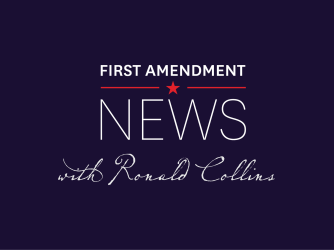Table of Contents
Deficient high school civic education contributing to issues on campus

I’ve only been with FIRE for a short month and a half; and yet already, I’ve seen numerous university policies discredited in the courts of law and public opinion. Because these successes for FIRE also have to be understood as a testament to the pervasiveness of First Amendment violations, my pride in FIRE is accompanied by a sober awareness of the situation on college campuses. A culture of censorship has taken root and permeated universities, in part due to some students’ unfamiliarity or disinterest in their rights. A likely culprit, in my opinion, is deficient civic education in secondary schools across the nation. In the absence of engaging civics instruction and classroom debate, some students fail to grasp the content or significance of their First Amendment freedoms, allowing those rights to fall victim to restrictions on campus.
To be clear, not all students are so naive or indifferent towards their freedoms. My fellow interns, for one, are far from that, and so are FIRE Student Network members, Student Defenders, and the other student activists taking stands for individual rights at their universities. In fact, over a hundred of them joined us in Philadelphia last weekend for FIRE’s tenth annual Student Network Conference.
Nevertheless, we can’t deny that some students lack critical knowledge about their rights. According to the Newseum Institute’s State of the First Amendment report, over a quarter of last year’s college graduates could not name a single First Amendment freedom. This comes as little surprise given that, in the year prior, another survey showed that 15 percent of recent graduates were unable to recognize those freedoms in a multiple choice question. Namely, they didn’t identify “freedom of speech,” “freedom of assembly,” or “right to petition the government” as a liberty protected by the First Amendment. It was in this same 2015 American Council of Trustees and Alumni (ACTA) survey that a third of our nation’s graduates failed to identify the Bill of Rights as “a group of Constitutional amendments.”
Whereas some students are unacquainted with their rights, others misunderstand the basis for unrestricted freedoms. They back First Amendment rights in theory, while simultaneously supporting campus policies that undermine them. Such a paradox was revealed in a 2016 study conducted by Gallup on behalf of the Knight Foundation and the Newseum Institute. Seventy-eight percent of college students found it more important for colleges to “create an open learning environment where students are exposed to all types of speech and viewpoints” than to “create a positive learning environment for all students by prohibiting certain speech or expression of viewpoints that are offensive or biased against certain groups of people”. Yet, many respondents at the same time believed that colleges should restrict slurs and intentionally offensive language (69 percent in favor), costumes stereotyping certain racial or ethnic groups (63 percent), and disturbing political expression (27 percent).
These contradictory beliefs point to an underlying misconception of the First Amendment’s theoretical underpinnings. Some students have not even considered the philosophical arguments behind their freedoms — namely, the arguments that epistemic humility (not being so sure you’re absolutely right) and open dialogue are the best means of discovering the truth. They presume that their freedoms can survive limitations on campus, failing to recognize that the business of curbing freedoms is a slippery slope — limit a freedom in one instance, and it will be wrongly lost in others.
It’s partially due to this unfamiliarity, misunderstanding, and disinterest that unconstitutional “red light” policies persist on campuses. Some students may not recognize infringements of their rights or understand why such policies are wrong. Others, out of unconcern, may accept limitations of their rights because they do not appreciate the significance of unrestricted freedoms. While far from representative of the entire collegiate demographic, these students reinforce campus censorship with their inaction and silence.
To understand the root of these shortcomings, we must look to what precedes college in the causal chain of student development: namely, high school. At the core of every secondary school career are academic courses, and when it comes to First Amendment issues, civic studies are most pertinent. It’s in government and American history classes that students are (ideally) exposed to key documents (such as the Bill of Rights) and their historical and philosophical significance. Civics experiences influence the extent to which students know, understand, and value their rights in college. Those who haven’t had the chance to study their constitutional freedoms are less likely to recognize First Amendment violations on campus.
Over the past few decades, people have readily acknowledged the value of civic education. State governments, along with civics advocacy nonprofits, have attempted to safeguard civics from a downhill slide that many believe began in the sixties. During that post-Sputnik era, civics took a backseat to STEM education and other types of social studies classes, such as history, economics, and psychology. Formal civic education was gradually condensed from a traditional three courses (civics, democracy, and government) to one at best.
Subsequently, at the turn of the 21st century, civic education fell further victim to federal prioritization of other academic disciplines. The No Child Left Behind Act (NCLB), passed in 2001, bolstered reading and math at the expense of civics in an effort to ensure the future success of students in the workplace. The Obama administration likewise emphasized STEM coursework, awarding student excellence in those fields. Teachers thus found themselves with less time to spend on government, history, and social science. The Center on Education Policy reported in 2007 that instructional time for subjects not tested under NCLB, such as civics, had declined by one-third.
In response, state governments worked to protect civics through legislation. All 50 states now require high schoolers to complete some form of civics or social studies coursework to graduate. And as of this January, fifteen states require students to pass the U.S. Citizenship Test before receiving a diploma. An abundance of new research informs such policies, illuminating the importance of civics and the steps necessary to achieve civic literacy. In 2010, the Department of Education, followed by a coalition of U.S. Congress members in 2012, reviewed reports on improving civics from organizations like the National Task Force on Civic Learning and Democratic Engagement and the American Academy of Arts and Sciences, respectively. A myriad of other research groups, like the Center for Information and Research on Civic Learning and Engagement, also advise state practice.
Despite these efforts, state legislation has fallen short, proving inadequate in combating the decline in civics education. For starters, few states hold secondary schools accountable for ensuring that their students retain civic knowledge. Only seventeen states include civic learning in their accountability frameworks, according to a December 2016 update released by the Education Commission of the States and the National Center for Learning and Civic Engagement. In the remaining 33 states, civics programs or student performance on civics assessments, if any, are overlooked in the evaluation of schools. Thirteen states meanwhile do not require students to display assessed proficiency in civics or social studies; and 30 states fail to offer curriculum support to high schools.
Such policy weaknesses inevitably translate to uninspiring civic classes. When teachers are pressed to teach math instead of civics, in-depth considerations of constitutional rights and their underpinnings simply fall to the wayside. Too often, civics instruction finds itself devoid of student discussion, simulations, or service learning. In California, for example, nearly half of the state’s public high school seniors reported that they lacked frequent opportunities to discuss current events or social problems in their civics class, while roughly 80 percent did not engage in frequent simulations of democratic processes and procedures.
Considering the failure of state regulations to protect civic education, it’s hardly a surprise that students lack knowledge about their First Amendment rights. We cannot expect high schoolers to fully grasp concepts that are covered cursorily, if taught at all. The gaps in their knowledge are only exacerbated by the uninspiring nature of today’s civics classes, which engender misunderstanding and disinterest in constitutional freedoms. With the lack of discourse or examination, students may adopt misconceptions about the First Amendment by conflating the right to speak with the content of said speech. Their will to uphold the security of their rights, in turn, becomes unduly precarious.
Ultimately, the price of poor quality civics is a collegiate demographic that consents to restrictions on expression. Given that such restrictions clearly conflict with the ideals underlying higher education, that cost is one that we as a society cannot afford to bear. We must revive civic education and employ other resources to ensure that universities are bastions of intellectual diversity, inclusion, and rational debate. With many courses of action still untested, the prospects of improvement are high once we’re willing to invest in civics as a cornerstone to free expression.
Katherine Hung is a rising sophomore at Harvard University and a FIRE summer intern.
In need of First Amendment resources for teachers? The Foundation for Individual Rights in Education has you covered. Our “First Things First” First Amendment textbook for college undergraduates explores the fundamentals of modern American free speech law. Meanwhile, our K-12 First Amendment curriculum modules help educators enrich and supplement their existing instruction on First Amendment and freedom of expression issues in middle and high school classrooms. Explore thefire.org for even more First Amendment educational resources.
Recent Articles
FIRE’s award-winning Newsdesk covers the free speech news you need to stay informed.

No, the Berkeley Law student didn’t have a First Amendment right to interrupt the dean’s backyard party

Salman Rushdie calls out left-wing censorship in CBS interview

Falsely claiming a First Amendment right at a dinner party at private home — FAN 419.1
